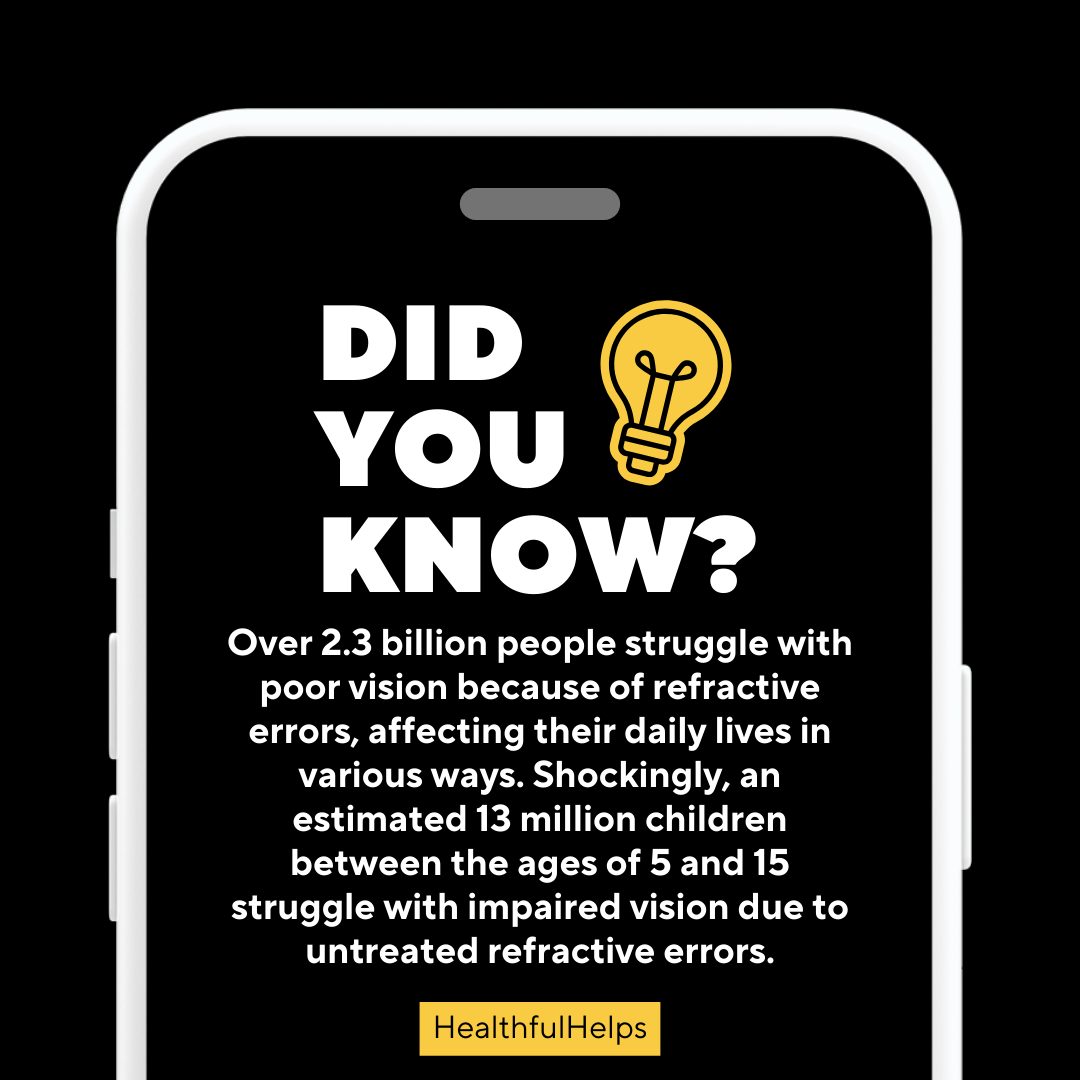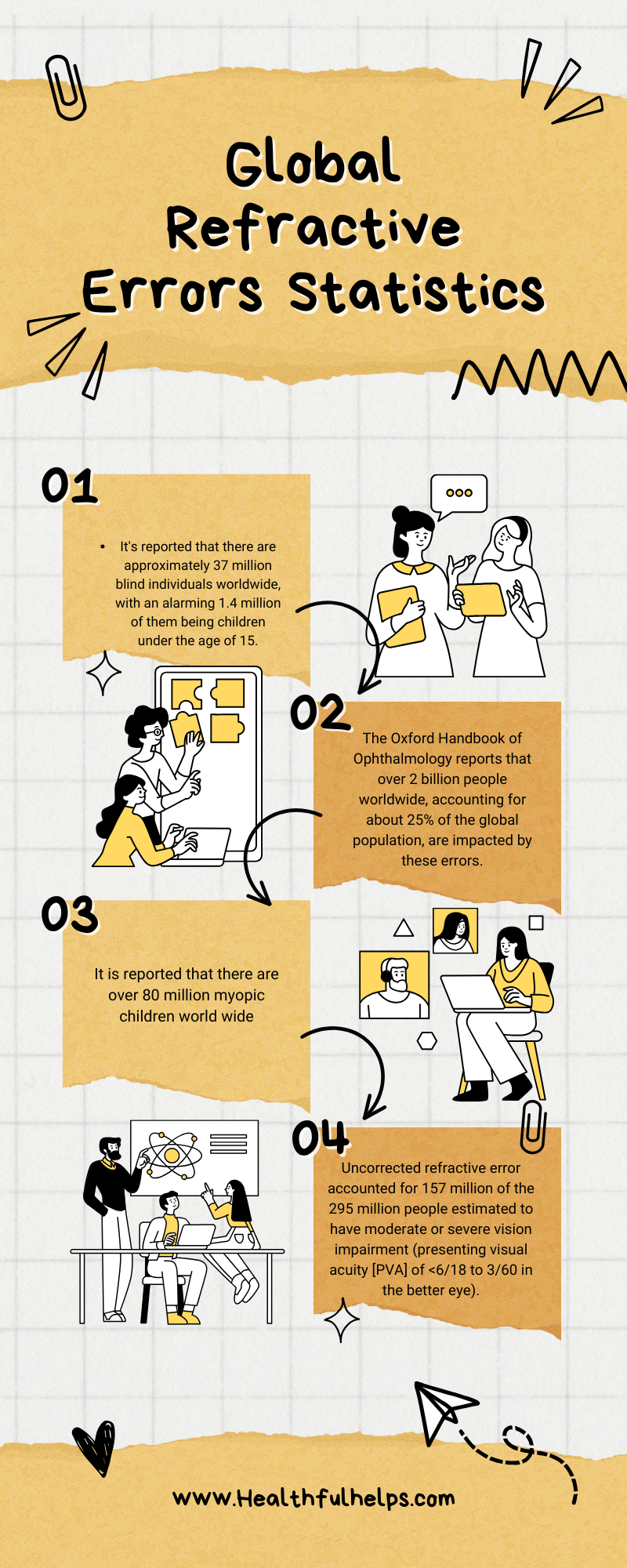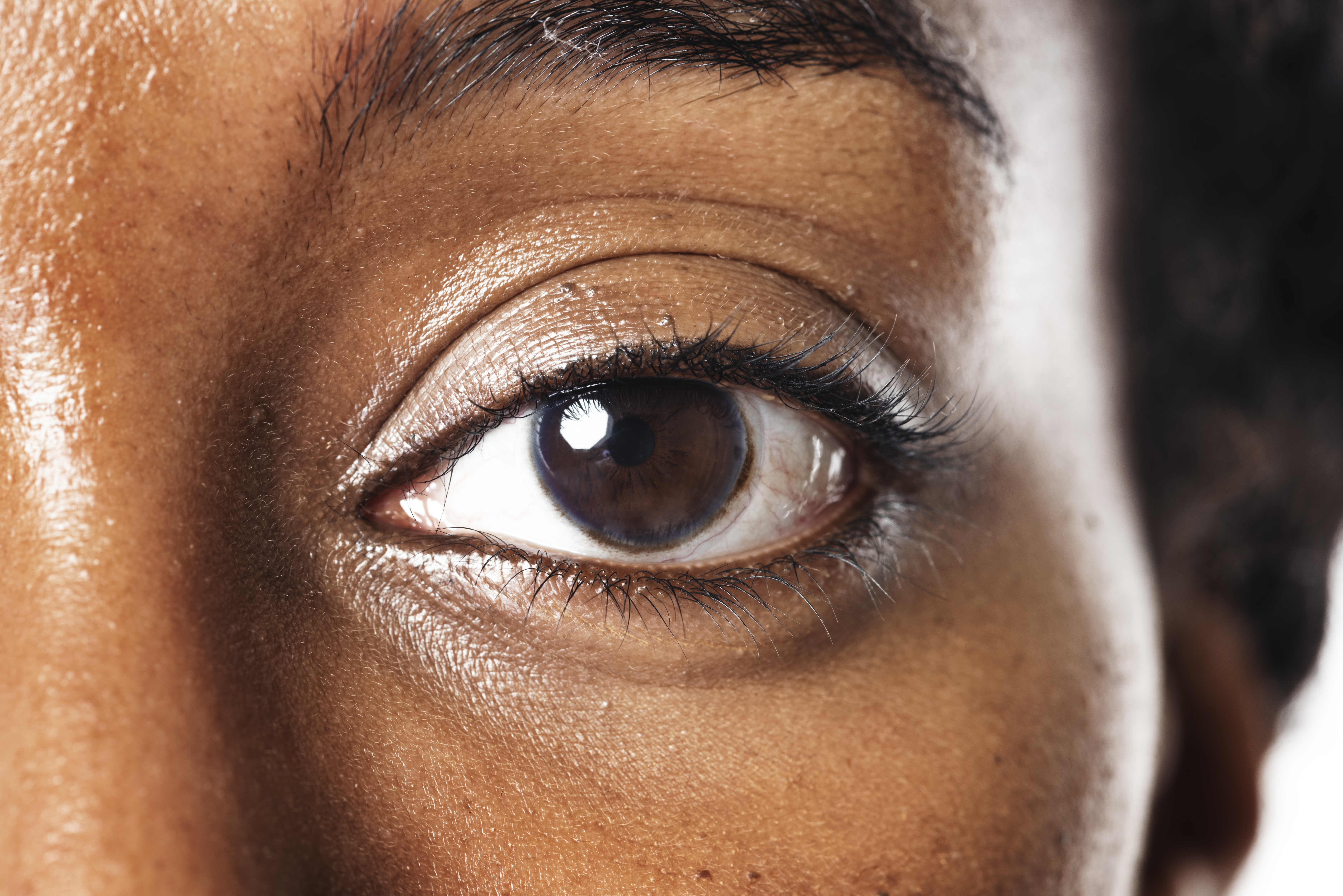30+ Refractive Error Facts & Statistics[New Data]

Refractive errors happen when the light entering our eyes doesn't focus properly on the retina at the back of the eye. Shockingly, the Oxford Handbook of Ophthalmology reports that over 2 billion people worldwide, accounting for about 25% of the global population, are impacted by these errors.
Table of Contents
- Refractive Error Statistics: Global Key Facts
- Top 5 Refractive Error Statistics
- Who Do Refractive Error Affect in the United States?
- What Do Refractive Error Really Cost?
- Statistics of People with Refractive Error
- Causes of Refractive Error
- Statistics by Region
- Demographic Trends
- Updates in December 2023
- Wrap Up
This widespread prevalence highlights the significant impact refractive errors have on individuals' vision and underscores the importance of accessible and effective solutions to address this issue.

Refractive Error Statistics: Global Key Facts
- Recent reports from 2020 highlight a significant global burden of visual impairment, with an estimated 43.3 million people suffering from blindness and an additional 295 million with moderate to severe visual impairment.
- These numbers are projected to rise substantially by 2050, reaching 61 million cases of blindness and 474 million cases of moderate to severe visual impairment.
- Globally, more than 800 million people have distance impairment (i.e. myopia and hypermetropia) or near vision impairment (i.e. presbyopia) that could be addressed with an appropriate pair of spectacles. An estimated 100 million people have moderate-to-severe distance vision impairment or blindness that could be corrected through access to cataract surgery.
Research indicates that hyperopia, or farsightedness, impacts approximately 4.6% of children and 30.9% of adults worldwide.
- Uncorrected refractive errors alone account for 86.1 million cases of moderate to severe visual impairment, making them a major public health concern.
- Studies focusing on older adults have reported refractive error prevalence rates exceeding 80% within this demographic.
- Age-related changes in ocular structures, particularly the crystalline lens and ocular pathologies, contribute significantly to refractive errors in older individuals.
- The elderly population faces a higher prevalence of ocular pathologies and a history of cataract surgery, which can influence the distribution and pattern of refractive errors.
- Given their association with decreased quality of life and visual impairment, refractive errors pose a significant health concern among the elderly population.
- Although previous studies have explored refractive errors in Iran, many have been limited by factors such as inadequate consideration of influential variables and small sample sizes, particularly among the elderly.
Source: WHO, Sciencedirect, CDC AAO
Top 5 Refractive Error Statistics
- It's reported that there are approximately 37 million blind individuals worldwide, with an alarming 1.4 million of them being children under the age of 15.
- Additionally, there are around 125 million people experiencing severe vision impairment. This totals over 160 million individuals globally who are visually impaired.
- The Oxford Handbook of Ophthalmology reports that over 2 billion people worldwide, accounting for about 25% of the global population, are impacted by these errors.
- Astigmatism is a common vision issue, affecting approximately one in three individuals.
- It is reported that there are over 80 million myopic children world wide
- Interestingly, the prevalence of astigmatism rises notably with age, increasing from around 14.3% in those under 15 years old to about 67.2% in individuals over 65 years old.
- Study revealed that uncorrected refractive errors contribute to a staggering annual economic loss of $269 billion globally.
- Uncorrected refractive error accounted for 157 million of the 295 million people estimated to have moderate or severe vision impairment (presenting visual acuity [PVA] of <6/18 to 3/60 in the better eye).

Who Do Refractive Error Affect in the United States?
Approximately 1.1 million Americans fall under the legally blind category, defined by best-corrected visual acuity worse than or equal to 20/200 in the better-seeing eye. A global surge in myopia is evident, with myopia being defined as 1.0 diopters or more.
Myopia is on the rise worldwide. (Myopia defined as 1.0 diopters or more.) The number of Americans who are nearsighted has nearly doubled over the last 50 years to about 41.6 percent.
Vision Impairment in the United States:
- Over 90 million Americans are at high risk for vision loss or impairment.
- Vision problems in Americans aged 40 and over have an annual economic impact exceeding $145 billion.
- Approximately 2.9 million Americans aged 40 and over have low vision, while 4.2 million are visually impaired.
Blindness in the United States:
- Approximately 1.3 million Americans are legally blind, with an expected increase to 2.176 million by 2050.
- The CDC estimates that 90% of diabetes-related blindness is preventable.
Refractive Errors in the United States:
- More than 34 million Americans aged 40 or older are nearsighted, while 14.2 million are farsighted.
- Around 1 in 3 Americans have astigmatism.
- Over 150 million Americans use corrective eyewear, spending approximately $15 billion annually.
- Approximately 800,000 surgical procedures to correct refractive errors are performed in the US each year.
Astigmatism is a frequent vision issue, affecting approximately one in three individuals. It can be present from birth or develop gradually over time, often alongside nearsightedness (myopia) or farsightedness (hyperopia).
Interestingly, the prevalence of astigmatism rises notably with age, increasing from around 14.3% in those under 15 years old to about 67.2% in individuals over 65 years old.
Myopia, which affects nearly 30% of the U.S. population, remains a prevalent vision condition. While its exact cause remains unknown, there's strong evidence suggesting a hereditary link. If one or both parents are nearsighted, their children have an increased likelihood of developing myopia.
Recent studies, such as the Sydney Myopia Study, reveal a growing trend in myopia among teenagers, with 31% of 17-year-olds affected. This prevalence has notably increased compared to studies conducted a decade ago.
Globally, high myopia, defined as over 5.00 D of myopia, affects approximately 2.9% of the population, totaling around 224 million people as of 2010.
Nearly 14 million Americans age 40 and older are hyperopic, or 10% of that population.[16] (Hyperopia defined as 3.0 diopters or more.)
Astigmatism Occurs in about 1 in 3 people and may occur in combination with near- or farsightedness. It causes blurry vision and is due to the cornea being less than perfectly rounded.
Also read about medical device usage statistics worldwide
What Do Refractive Error Really Cost?
Refractive errors not only impact individuals' vision but also have significant economic implications for societies worldwide. A study revealed that uncorrected refractive errors contribute to a staggering annual economic loss of $269 billion globally.
Moreover, the economic burden is particularly noteworthy in individuals aged 50 and above, with an index of $121.4 billion.
During the forecast period of Databridge research,Uncorrected Refractive Errors Market is expected to experience a growth rate of approximately 6.41%.
This indicates a steady and promising trajectory for the market, reflecting increasing awareness and demand for solutions to address refractive errors globally.
As advancements in technology and healthcare continue to unfold, the market is poised to expand further, offering hope for improved vision outcomes and enhanced quality of life for individuals affected by refractive errors.
Some of the major players operating in the uncorrected refractive errors market are:
Abbott Medical Optics, Inc. (U.S.)
Carl Zeiss AG (Germany)
Alcon, Inc. (Switzerland)
Bausch & Lomb Incorporated (Canada)
Topcon corporation (Japan)
Ellex Medical Lasers Limited (U.S.)
Lumenis Ltd. (U.S.)
SCHWIND eye-tech-solutions GmbH & Co. KG (Germany)
Ziemer Ophthalmic Systems AG (Switzerland)
Nidek Co., Ltd. (U.S.)
Johnson & Johnson Vision (U.S.)
Source: Databridge Market
Statistics of People with Refractive Error
Uncorrected refractive error plays a significant role in vision impairment, affecting a substantial portion of the global population.
Out of the estimated 295 million people with moderate or severe vision impairment, 157 million are attributed to uncorrected refractive error.
Additionally, 257.8 million individuals, constituting 3.3% of the world's population, experience mild vision impairment.
A striking 22.1% of individuals aged 50 and older, approximately 509.7 million people, face near vision impairment due to uncorrected or undercorrected presbyopia.
- A recent report by the Vision Loss Expert Group estimated that approximately 510 million people worldwide had uncorrected presbyopia in 2020.
- Data from the United Nations in April 2022 suggested a global population of 7.9 billion people.
- In 2015, around 1.8 billion individuals were identified as presbyopic, with projections indicating an increase to 2.1 billion by 2020.
- This means that approximately 26% of the world's population is currently affected by presbyopia.
- In the United States, presbyopia prevalence among adults aged 45 and older ranges from 83.0% to 88.9%.
- An estimated total of 123 million presbyopes were identified in America in 2020.
- The greatest burden of vision impairment from uncorrected presbyopia is observed in developing, low-resource countries, where up to 94% of the population may lack proper correction.
- In 2015, the global unmet need for presbyopia correction was estimated at 45%.
- Near vision correction rates ranged from 96% in Europe to only 6% in Africa.
Notably, there is a growing concern about an epidemic of both myopia and high myopia in East and Southeast Asia, potentially leading to increased vision loss from pathological myopia. Simultaneously, aging populations globally contribute significantly to the rising prevalence of presbyopia.
Myopia, which affects nearly 30% of the U.S. population, remains a prevalent vision condition. While its exact cause remains unknown, there's strong evidence suggesting a hereditary link. If one or both parents are nearsighted, their children have an increased likelihood of developing myopia.
Recent studies, such as the Sydney Myopia Study, reveal a growing trend in myopia among teenagers, with 31% of 17-year-olds affected. This prevalence has notably increased compared to studies conducted a decade ago.
Globally, high myopia, defined as over 5.00 D of myopia, affects approximately 2.9% of the population, totaling around 224 million people as of 2010.
These statistics underscore the urgent need for widespread access to vision correction and comprehensive eye care to address the escalating challenges posed by refractive errors on a global scale.
Source : The Lancet WHO NIH CDC AAO
Causes of Refractive Error
Refractive errors can arise from various factors, including:
- Eyeball length: When the eyeball grows either too long or too short, it can disrupt the proper focusing of light onto the retina at the back of the eye.
- Corneal shape issues: Problems with the shape of the cornea, which is the transparent outer layer of the eye, can lead to refractive errors by affecting how light enters the eye and is focused.
- Aging of the lens: The lens inside the eye, which is normally clear and aids in focusing, can undergo age-related changes that impact its ability to bend light accurately, contributing to refractive errors.
Statistics by Region
The prevalence of refractive errors varies across different regions:
In children:
- Myopia: Ranged from 4.9% in South–East Asia to 18.2% in the Western Pacific region.
- Hyperopia: Ranged from 2.2% in South-East Asia to 14.3% in the Americas.
- Astigmatism: Ranged from 9.8% in South-East Asia to 27.2% in the Americas.
In adults:
- Myopia: Ranged from 16.2% in the Americas to 32.9% in South-East Asia.
- Hyperopia: Ranged from 23.1% in Europe to 38.6% in Africa and 37.2% in the Americas.
- Astigmatism: Ranged from 11.4% in Africa to 45.6% in the Americas and 44.8% in South-East Asia.
Source : WHO reports
Demographic Trends
The study reveals significant gender differences in the prevalence of refractive errors, with males exhibiting higher rates of myopia and astigmatism compared to females. This aligns with previous research findings.
Myopia prevalence decreases with age, peaking during school years and gradually stabilizing towards adulthood, followed by a second peak in older age groups, attributed to cataract incidence.
Hyperopia prevalence increases with age, especially among females, likely due to age-related changes in ocular structures.
Astigmatism prevalence also rises with age, influenced by various factors including ethnicity, genetic predisposition, and ocular biomechanics.
Low astigmatism is the most common type, impacting unaided visual acuity and symptoms.
Related: Contact lenses Usage Statistics
Updates in December 2023
A recent report from the World Health Organization (WHO) sheds light on the limited access to quality vision correction for individuals with refractive errors globally. Shockingly, only 36% of those affected have been able to obtain a good quality pair of spectacles.
In response to this concerning issue, the World Health Assembly took a significant step in 2021 by endorsing the first-ever global target aimed at improving access to vision correction. This target specifically aims for a 40-percentage point increase in effective coverage for refractive error.
To support Member States in achieving this ambitious target, WHO has planned a comprehensive global initiative titled "WHO SPECS 2030", set to launch in 2023.
This initiative underscores the importance of addressing vision impairment due to refractive error and aims to bring about meaningful change by expanding access to quality vision correction services worldwide.
Wrap Up
Refractive errors represent a substantial global health challenge, with millions of individuals affected by visual impairment. Uncorrected refractive errors and cataracts stand out as leading causes of visual impairment, contributing significantly to the global burden of blindness and moderate to severe visual impairment.
Studies focusing on older adults have underscored the high prevalence of refractive errors within this demographic, with age-related changes in ocular structures playing a key role.
Despite advancements in healthcare, there remains a need for comprehensive research and interventions targeted at addressing refractive errors, particularly among the elderly population.

